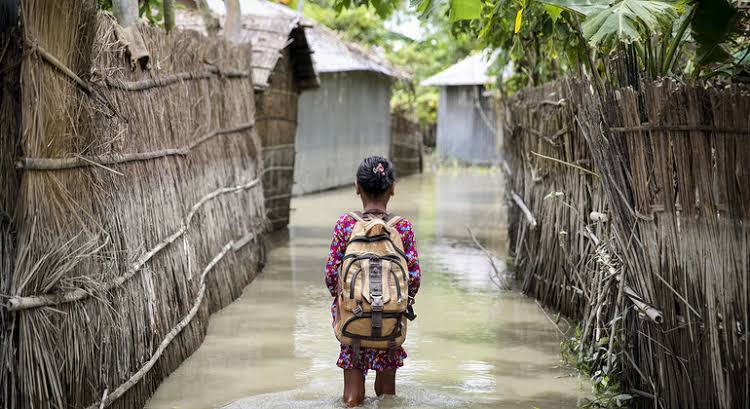Staff Correspondent
Published:2021-11-02 04:56:49 BdST
1bn children at extremely high risk of climate change: Unicef
United Nations Children's Fund (Unicef) Executive Director Henrietta Fore has said that climate change is one of the greatest threats facing this generation, with one billion children – nearly half the world’s children - at “extremely high risk”.
Stating that “COP26 must be the COP for children”, Fore said, “While the outlook is dire, world leaders at COP26 have a significant, time-sensitive opportunity to redirect the terrible path we are on.”
“They can do so by committing to strengthening the resilience of services that children depend upon, and by cutting emissions faster and deeper. The futures of billions of children depend on it,” she said.
Unicef will be at COP26 to ensure that the climate crisis is recognized as a crisis for children and their rights, to promote approaches to decrease climate risk for those who are most vulnerable.
United Nations agency will also support children and young people’s participation in COP26 as part of efforts to support children and young people’s participation in climate-related decision-making.
Climate crisis is a child rights crisis
Climate change poses a major threat to children and young people’s health, nutrition, education, development, survival and future potential.
Compared to adults, children require more food and water per unit of their body weight, are less able to survive extreme weather events, and are more susceptible to toxic chemicals, temperature changes and diseases, among other factors.
Critically, current and future generations of children will have to navigate an uncertain future where the current model of growth that links economic development to environmental exploitation is no longer viable.
Children in communities that have contributed the least to global emissions will face the greatest impacts of climate change. Building the resilience of social services that these children will depend upon is critical to reduce the risks they will face.
Key facts about children and climate
An August Unicef report, The Children’s Climate Risk Index (CCRI), found almost every child on earth is exposed to at least one climate and environmental hazard, such as heatwaves, cyclones, air pollution, flooding and water scarcity.
These children face a deadly combination of exposure to multiple climate and environmental shocks with a high vulnerability due to inadequate essential services, such as water and sanitation, healthcare and education.
An estimated 850 million children – over one third of all children – live in areas where at least four of climate and environmental shocks overlap, and as many as 330 million children live in areas affected by a staggering five major climate shocks.
Children from countries that contribute the least to climate change suffer the greatest consequences.
The 33 extremely high-risk countries collectively emit 9 per cent of CO2 emissions.
The 10 highest-risk countries collectively emit only 0.5 per cent of global emissions.
Improving the resilience of key services that children depend upon is often the best investment to reduce the risks they face.
Access to resilient water, sanitation and hygiene services reduces risks for 415 million children.
Climate-smart health services reduce risks for 460 million children.
Resilient schools and education systems reduce risks for 275 million children.
And climate-responsive social safety nets reduce risks for 310 million children.
UNICEF’s call on governments
UNICEF urged governments to increase investment in climate adaptation and resilience.
It urged developed countries to exceed their 2009 promise to mobilize $100 billion annually in climate finance in light of evidence that these sums are insufficient to address the scale of climate impacts.
It also called for a greater emphasis on funding to build climate resilience and adaptive capacity.
The UN agency said, mitigation efforts will take decades to reverse the impacts of climate change, and for the children of today, this will be too late.
“Unless we invest heavily in adaptation and resilience of social services for the 4.2 billion children born over the next 30 years, these children will face increasingly high risks to their survival and well-being,” it said.
It also urged to adapt critical services, such as water, sanitation and hygiene systems, health and education services.
UNICEF urged countries to cut their emissions by at least 45 per cent (compared to 2010 levels) by 2030 to keep warming to no more than 1.5 degrees Celsius.
Governments are woefully off track to meet this goal, with the UNFCCC warning existing climate mitigation targets could lead to a temperature rise of about 2.7 degrees Celsius by the end of the century.
For every fraction of a degree of warming, scientists say more extreme heat waves, floods and droughts can be expected.
It urged governments to include young people in all climate negotiations and decisions.
Children and young people are underrepresented in policies and policy discussions despite being the major stakeholder in their outcomes.
They are therefore limited in their ability to influence decisions that are critical to their future.
Children’s rights and voices must be reflected and included in the implementation of the Paris Agreement at national, regional and international levels. COP26 presents a critical opportunity to formalise this. 2022 will mark 30 years since the UNFCCC Convention was drafted and yet in that time, there has never been a decision focused on children and young people in climate action taken under the UNFCCC.
Every government must provide climate education for children and young people so that they can meaningfully contribute to and participate in climate policy and action, UNICEF said.
Unauthorized use or reproduction of The Finance Today content for commercial purposes is strictly prohibited.


